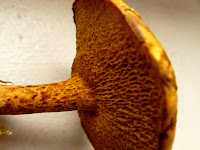 A couple of weeks ago, after hurricane Irene, I picked a large variety of pored mushrooms from the lawns around where I live and promised here that I would try to post something about them once a week. Actually, with a newborn at home now, I was lucky to find some time today to write this little post.
A couple of weeks ago, after hurricane Irene, I picked a large variety of pored mushrooms from the lawns around where I live and promised here that I would try to post something about them once a week. Actually, with a newborn at home now, I was lucky to find some time today to write this little post.The mushroom I'll describe in detail below was specially interesting to me since it had a variety of peculiar phenotypic characteristics (i.e. apressed patches, glandular stipe, sticky surface etc) that made it easily stand out from the crowd.
Date: 09/05/2011
Location: Rollins Park, MD
Habitat: Solitary, growing on grass/moss, near pine trees
Measurements
Pileus diameter - 5.0 cm
Pileus height - 15 mm
Stipe length - 37.7 mm
Stipe diameter at apex - 8.7 mm
Stipe diameter at middle - 7.1 mm
Stipe diameter at base - 7.1 mm
 Description
DescriptionPileus - yellow with brown appressed patches, flat with umbo and depression around it, round, margin is entire, smell is fragrant, somethwat citric. Context is light yellow, doesn't stain, flavor is somewhat acidic.
Hymenium - with large (~1mm) pores, beige with orange tone, does not stain when bruised, tubes are 5-6 mm long
Stipe - central, solid, equal, slender, with red/orange spots, sticky on the outside (resinous), color is similar to hymenium, does not stain when bruised, with glandular dots, without ring.
Spore print - ochre/brown
 Impressions
ImpressionsThis is a member of the Suillus genus, most probably Suillus americanus, an edible (some consider it choice, most consider it mediocre) mushroom that grows under white pine in eastern North America. Some of the characteristics of the specimen I found don't fit with the description from the key in North American Boletes. For instance, the mushroom did not stain my fingers, flavor was a bit acid (it should have mild non-distinctive taste) and the context did not stain purplish-brown when cut (I did not notice any staining at all). Despite the differences, I would still call it S. americanus given that all the other characteristics fit the key and it looks a lot like the photos from all my guide books. According to Roody's Mushrooms of West Virginia, there are reports that this mushroom can cause allergic contact dermatitis in some individuals and, according to Kuo's 100 Edible Mushrooms, it causes gastrointestinal irritation in some individuals. Some lookalikes are S. subaureus, which grows in broad-leaved woods, and S. sibiricus which has brown spots on the pileus, is darker or more dingy yellow, has a thicker stipe and is also associated with pine. To my knowledge there aren't any poisonous Suillus mushrooms.
References
Bessette AE, Roody WC and Bessette AR. North American Boletes, A Color Guide to the Fleshy Pored Mushrooms, Pages 227 and 332.
Kuo M. 100 Edible Mushrooms. Pages 215-6.
Lincoff GH. National Audubon Society Field Guide to North American Mushrooms, Page 581.
Roody WC. Mushrooms of West Virginia and the Central Appalachians, Page 335.






Now is this edible, I have a huge fairy ring under my white pines.
ReplyDeleteThis is edible but is mediocre.
ReplyDeleteI just found it in my yard under pines. Thanks for information. (I'm in outside Nashville)
ReplyDeleteIt is best used as a dry mushroom. The flavor becomes very rich after drying.
ReplyDelete